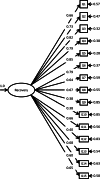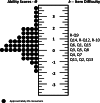Measuring Mental Health Recovery: An Application of Rasch Modeling to the Consumer Recovery Measure
- PMID: 24870400
- PMCID: PMC4691583
- DOI: 10.1007/s11414-014-9411-1
Measuring Mental Health Recovery: An Application of Rasch Modeling to the Consumer Recovery Measure
Abstract
As the need for recovery-oriented outcomes increases, it is critical to understand how numeric recovery scores are developed. In the current article, the modern Rasch modeling techniques were applied to establish numeric scores of consumers' perceptions of recovery. A sample of 1,973 adult consumers at a community-based mental health center (57.5% male; average age of 47 years old) completed the 15-item Consumer Recovery Measure. A confirmatory factor analysis revealed the unidimensional nature of the Consumer Recovery Measure and provided construct validity evidence. The Rasch analysis displayed that the items produced acceptable model fit, reliability, and identified the difficulty of the items. The conclusion emphasizes the value of Rasch modeling regarding the measurement of recovery and its relevance to consumer-derived assessments in the clinical decision-making process.
Keywords: Classical Test Theory; Measurement; Rasch Modeling; Recovery.
Conflict of interest statement
The authors have no conflict of interests to declare.
Figures


Similar articles
-
Measuring recovery related outcomes: a psychometric investigation of the recovery markers inventory.Community Ment Health J. 2014 Nov;50(8):896-902. doi: 10.1007/s10597-014-9728-5. Epub 2014 May 18. Community Ment Health J. 2014. PMID: 24838373 Free PMC article.
-
Recovery Assessment Scale-Domains and Stages: Measurement capacity, relevance, acceptability and feasibility of use with young people.Early Interv Psychiatry. 2020 Apr;14(2):179-187. doi: 10.1111/eip.12842. Epub 2019 Jul 5. Early Interv Psychiatry. 2020. PMID: 31274238
-
Factor validation and Rasch analysis of the individual recovery outcomes counter.Disabil Rehabil. 2019 Jan;41(1):74-85. doi: 10.1080/09638288.2017.1375030. Epub 2017 Sep 11. Disabil Rehabil. 2019. PMID: 28893097
-
Validation of the brief version of the Recovery Self-Assessment (RSA-B) using Rasch measurement theory.Psychiatr Rehabil J. 2015 Dec;38(4):349-58. doi: 10.1037/prj0000139. Epub 2015 Jun 15. Psychiatr Rehabil J. 2015. PMID: 26075526
-
From Classical Methods to Generative Models: Tackling the Unreliability of Neuroscientific Measures in Mental Health Research.Biol Psychiatry Cogn Neurosci Neuroimaging. 2023 Aug;8(8):822-831. doi: 10.1016/j.bpsc.2023.01.001. Epub 2023 Jan 11. Biol Psychiatry Cogn Neurosci Neuroimaging. 2023. PMID: 36997406 Free PMC article. Review.
Cited by
-
Measuring recovery related outcomes: a psychometric investigation of the recovery markers inventory.Community Ment Health J. 2014 Nov;50(8):896-902. doi: 10.1007/s10597-014-9728-5. Epub 2014 May 18. Community Ment Health J. 2014. PMID: 24838373 Free PMC article.
-
Assessing vulnerability to risk of suicide and self-harm in prisoners: a Rasch analysis of the suicide concerns for offenders in the prison environment (SCOPE-2).BMC Psychiatry. 2020 Apr 15;20(1):164. doi: 10.1186/s12888-020-02569-1. BMC Psychiatry. 2020. PMID: 32295553 Free PMC article.
References
-
- Young SL, Ensing DS. Exploring recovery from the perspective of people with psychiatric disabilities. Psychiatric Rehabilitation Journal. 1999;22:219–231. doi: 10.1037/h0095240. - DOI
-
- Bullock WA, Smith MK, O’Rourke M. Recovery outcomes of the Illness Management and Recovery Program. Presented at the 16th annual conference on State Mental Health Agency Services Research, Program Evaluation, and Policy, Baltimore, MD, February, 2006.
-
- Young SL, Bullock WA. The mental health recovery measure. Presented at the annual meeting of the American Psychological Association, San Francisco, CA, 2003.
MeSH terms
LinkOut - more resources
Full Text Sources
Other Literature Sources
Medical
Research Materials

